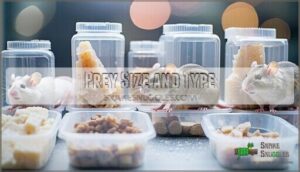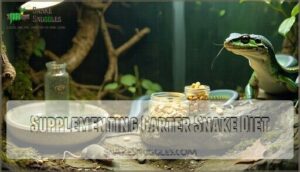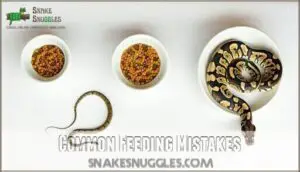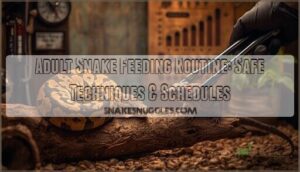This site is supported by our readers. We may earn a commission, at no cost to you, if you purchase through links.
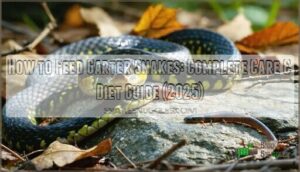 Learning how to feed garter snakes properly starts with understanding their carnivorous nature. You’ll need to offer appropriately sized prey like earthworms, fish, or small rodents based on your snake’s age and size.
Learning how to feed garter snakes properly starts with understanding their carnivorous nature. You’ll need to offer appropriately sized prey like earthworms, fish, or small rodents based on your snake’s age and size.
Juveniles thrive on nightcrawlers and small fish pieces, while adults can handle larger prey items. Feed juveniles every 3-4 days and adults weekly.
Always use pre-killed frozen prey that’s been thawed to room temperature – it’s safer than live feeding. Your snake’s head width determines proper prey size; anything larger risks regurgitation.
Temperature matters too, as cold food can cause digestive issues. Mastering these fundamentals opens the door to advanced feeding strategies that’ll keep your slithery friend thriving.
Table Of Contents
- Key Takeaways
- Feeding Garter Snakes Basics
- How to Feed Garter Snakes
- Choosing Right Food
- Feeding Techniques and Schedules
- Supplementing Garter Snake Diet
- Common Feeding Mistakes
- Frequently Asked Questions (FAQs)
- What is a garter snake’s favorite food?
- How do I know if my garter snake is hungry?
- How often should I feed my pet garter snake?
- How to get a garter snake to trust you?
- Do garter snakes need water bowls daily?
- Can garter snakes eat during winter months?
- How to store frozen garter snake food?
- Do garter snakes hunt at night?
- Should pregnant garter snakes eat differently?
- Conclusion
Key Takeaways
- Feed juveniles every 3-4 days and adults weekly – You’ll need to adjust the frequency based on your snake’s age, with hatchlings requiring the most frequent meals every 2-3 days.
- Use pre-killed frozen prey that’s properly thawed – You should thaw frozen food to room temperature before feeding, as this prevents digestive issues and eliminates injury risks from live prey.
- Match prey size to your snake’s head width – You can’t feed anything larger than 1-2 times your snake’s head diameter without risking regurgitation or choking.
- Provide variety with earthworms, fish, and small rodents – You’ll maintain better nutrition by rotating between different prey types rather than sticking to just one food source.
Feeding Garter Snakes Basics
Feeding your garter snake properly requires understanding their carnivorous nature and specific dietary needs. You’ll need to provide appropriate prey items while avoiding foods that can harm your snake’s health.
Dietary Requirements
Since garter snakes are obligate carnivores, your snake’s dietary needs revolve around whole animal prey for proper snake nutrition.
Their bodies can’t process plant matter, making nutrient balance vital through food variety including rodents, fish, and earthworms.
Effective meal planning guarantees your garter snake diet meets all dietary needs without deficiencies that compromise health.
Understanding the snake’s natural food sources is essential for creating a well-balanced diet.
Safe Food Options
When building your garter snake’s menu, variety becomes your best friend for ideal nutrition.
These adaptable hunters thrive on diverse prey that mirrors their wild feeding patterns.
Safe Food Options for Your Garter Snake:
- Fish Options – Feeder guppies, minnows, and salmon provide excellent protein
- Earthworms – Canadian nightcrawlers offer reliable nutrition and easy digestion
- Rodent Foods – Pinkie mice deliver complete nutrition for larger snakes
- Insect Diet – Crickets and mealworms work perfectly for smaller specimens
- Prey Variety – Rotating between different food types prevents nutritional gaps
Understanding the proper feeding schedule is vital for maintaining a healthy garter snake.
Foods to Avoid
The wrong foods can turn your pet snake into a health disaster.
Never feed human food, processed meat, or toxic fish containing thiaminase, which causes vitamin B1 deficiency and nervous system collapse.
Avoid wild prey like frogs and toads due to parasite risks, plus any processed foods lacking proper nutrition for carnivorous reptiles.
How to Feed Garter Snakes
Proper feeding technique transforms your garter snake care from guesswork into confident reptile management.
You’ll want to establish a consistent routine that mimics natural hunting patterns while ensuring safety for both you and your snake.
Here’s your step-by-step garter snake feeding process:
- Prepare the feeding environment – Use separate feeding containers to prevent substrate ingestion and reduce territorial behavior during meals.
- Thaw frozen prey completely – Room temperature prey prevents digestive issues and feels more natural to your snake’s heat-sensing abilities.
- Use feeding tongs or tweezers – This prevents accidental bites and allows you to simulate prey movement for motion-dependent feeders.
- Offer food at the snake’s head level – Present prey items directly in front of your snake’s nose to trigger natural feeding responses.
- Allow adequate feeding time – Give your snake 15-20 minutes to consume prey without rushing the process.
Remember that new snakes may refuse food initially, requiring 1-2 weeks for adaptation to their new environment and feeding schedule.
Choosing Right Food
Selecting the right food for your garter snake depends on three key factors: prey size, freshness, and nutritional value.
Whether you choose live or frozen options, the food must be appropriately sized and safe for your snake’s digestive system, considering complete concepts for the best results.
Prey Size and Type
Getting the prey item size right makes all the difference in your garter snake’s feeding success. Choose prey no larger than 1-2 times your snake’s head diameter for safe swallowing.
| Snake Size | Recommended Prey |
|---|---|
| Hatchlings (6-8 inches) | Pinky mice pieces, small earthworms |
| Juveniles (12-14 inches) | Whole pinky mice, medium earthworms |
| Adults (18+ inches) | Adult mice, large fish fillets |
Food variety keeps your snake healthy and engaged. Rotating between mice, fish, and earthworms prevents nutritional deficiencies while mimicking natural snake nutrition patterns. Understanding mouse breeding practices is vital for selecting the right prey items for your garter snake.
Feeding Live Prey
Live prey feeding stimulates your garter snake’s natural hunting instincts and provides mental enrichment.
Choose appropriately sized prey items like earthworms, feeder guppies, or minnows—nothing larger than twice your snake’s head diameter.
While live feeding encourages natural behaviors, it carries parasite risks and potential injuries from aggressive prey.
Source live prey from reputable suppliers to minimize health concerns.
Monitor feeding sessions closely in separate enclosures to prevent competition between multiple snakes.
Understanding the snake’s natural diet habits is essential for providing a balanced and nutritious diet.
Live prey can pose significant risks, including parasite transmission and the potential for aggressive prey to injure your snake.
Feeding Frozen Prey
Frozen prey offers convenience and safety for feeding garter snakes. Pre-killed frozen mice eliminate injury risks while providing complete nutrition. Proper thawing techniques guarantee your snake receives appetizing meals.
When selecting frozen mouse prey, consider the nutritional value of frozen mouse products.
Defrosting Methods That Work:
- Overnight refrigerator thawing – The safest method that preserves nutritional value and prevents bacterial growth in your frozen mouse
- Warm water bath defrosting – Quick 15-minute technique using sealed bags to rapidly prepare frozenthawed mice for hungry snakes
- Room temperature thawing – Convenient 2-3 hour process that fits most feeding schedules without rushing your preparation time
- Proper prey storage rotation – First-in, first-out system prevents freezer burn and maintains best nutrition for your garter snake diet
Never microwave frozen prey, as this creates dangerous hot spots. Always test temperature before feeding – lukewarm feels natural to snakes.
Store frozen mice in labeled containers with dates for organized feeding schedules.
Feeding Techniques and Schedules
Getting the timing and techniques right transforms feeding from a chore into successful snake care.
You’ll need to establish consistent schedules and proper portion sizes to keep your garter snake healthy and thriving.
Feeding Frequency
How often should you feed your garter snake? Feeding schedules depend on your snake’s age and growth stage.
Hatchlings need meals every 2-3 days, while juveniles thrive on feeding every 4-5 days.
Adult garter snakes maintain ideal health with weekly feeding cycles.
Dietary rhythms adjust based on prey type—earthworm diets require twice-weekly meals due to lower nutritional density.
Portion Control
Controlling portion sizes helps your garter snake maintain healthy health without the risks of overfeeding or underfeeding.
Proper meal sizes create a visible bulge in your snake’s midsection after eating, indicating adequate food quantity while supporting healthy digestion rates.
- Target a visible bulge – Feed enough to create a noticeable but not excessive bulge in your snake’s midsection
- Match prey to snake weight – Choose food items that are 1-2 times the diameter of your snake’s head
- Monitor feeding amounts – Adjust portion sizes based on your snake’s age, size, and activity level
- Follow feeding guidelines – Adult snakes need larger meals less frequently than juveniles requiring smaller portions
- Maintain balanced diet – Rotate between different prey types while keeping consistent feeding frequency and appropriate meal sizes
Feeding Hatchlings and Juveniles
Young garter snakes need more frequent meals than adults to fuel their rapid growth.
Their hatchling diet requires feeding every 2 days with pinky mice pieces, while juveniles eat whole pinky mice every 4-5 days.
Proper juvenile nutrition during these critical growth stages sets the foundation for healthy adult snakes.
Understanding a suitable feeding schedule is essential for their development.
| Age Group | Feeding Schedule | Food Type |
|---|---|---|
| Hatchlings | Every 2 days | Pinky mice pieces |
| Juveniles | Every 4-5 days | Whole pinky mice |
| Adults | Every 7-10 days | Adult mice/varied diet |
Baby garter snakes can eat more frequently than adults, possibly every second day on a worm diet.
Monitor growth rates closely and adjust feeding schedules accordingly.
Neonate care requires patience as new snakes may refuse food initially—allow 1-2 weeks for adaptation to their new environment.
Supplementing Garter Snake Diet
Even the most nutritious whole prey items might leave gaps in your garter snake’s dietary needs, making targeted supplementation essential for peak health.
You’ll need to carefully balance calcium, phosphorus, and vitamin D while avoiding the dangerous pitfalls of over-supplementation.
Calcium and Vitamin D
Calcium supplements and vitamin D3 work together like a perfectly choreographed dance for bone health.
Your garter snake needs a 2:1 calcium to phosphorus ratio to prevent calcium deficiency and metabolic bone disease.
Vitamin D3 enhances nutrient absorption, allowing your snake to utilize dietary calcium effectively.
Whole prey naturally provides better mineral balance than chopped foods, reducing supplement dependence substantially.
Providing the right calcium supplements is essential for maintaining strong bones and overall health in garter snakes.
Avoiding Over-Supplementation
While calcium supplements benefit your garter snake’s health, you can definitely have too much of a good thing.
Supplement overdosing creates toxic levels that harm rather than help your pet.
Watch for these warning signs that indicate you’re crossing the line from helpful to harmful:
- Monitor vitamin balance – Excess vitamin D becomes toxic faster than deficiency symptoms appear
- Track mineral supplements – Too much calcium blocks absorption of other essential nutrients
- Check nutrient ratios – Dietary additives should complement, not overwhelm natural prey nutrition
- Recognize overfeeding symptoms – Lethargy, poor appetite, or digestive issues signal supplement excess
Rotating Supplement Brands
Just as overdosing threatens your snake’s health, relying on one supplement brand creates nutritional gaps.
Rotating supplement brands guarantees thorough nutrient coverage and prevents deficiencies that single-source supplementation might miss.
| Brand Type | Primary Benefits | Rotation Schedule |
|---|---|---|
| Calcium-focused brands | Bone development, metabolic support | Weekly alternation |
| Multi-vitamin formulas | Broad spectrum nutrition, immune health | Bi-weekly rotation |
| Specialized reptile supplements | Species-specific nutrients, digestive health | Monthly inclusion |
| Trusted supplement brands | Quality assurance, consistent potency | Quarterly evaluation |
This garter snake feeding guide approach mimics natural dietary diversity while preventing supplement overdosing through varied calcium sources and nutrient balance.
Common Feeding Mistakes
Even experienced keepers make costly mistakes that can harm their garter snake’s health and wellbeing.
You’ll want to recognize these common pitfalls early to prevent nutritional deficiencies, obesity, and feeding-related stress in your snake.
Overfeeding and Underfeeding
Getting your garter snake feeding guide right means avoiding both extremes. Overfeeding creates snake obesity and digestive issues, while underfeeding causes malnutrition and weakness.
Watch for these nutrition risks:
- Visible fat deposits around the neck
- Sluggish movement after meals
- Protruding ribs or spine
- Difficulty shedding skin
- Food refusal or aggression
Proper feeding limits and diet balance prevent these feeding errors completely. Understanding common feeding mistakes is essential to maintaining a healthy garter snake. Avoiding extremes and recognizing nutrition risks are key to a successful feeding strategy.
Preventing Food Allergies
Food allergies aren’t common in garter snakes, but food intolerance can develop from poor dietary variety.
Rotating different prey types prevents nutritional deficiencies and reduces allergic responses. Monitor your snake for unusual reactions after feeding new items.
| Warning Signs | Common Triggers | Prevention Tips |
|---|---|---|
| Regurgitation after meals | Single food source diet | Rotate prey types weekly |
| Skin irritation or swelling | Thiaminase-rich fish | Avoid goldfish, use guppies |
| Lethargy or appetite loss | Contaminated earthworms | Source from reputable suppliers |
| Digestive upset patterns | Processed food items | Stick to whole prey only |
Breeding and Growth Stage Diets
Different life stages require customized nutrition approaches that many keepers overlook.
You can’t feed a breeding female the same way you’d feed a hatchling without consequences.
Growth stage diets should reflect these specific needs:
- Hatchling care demands frequent small meals every 2-3 days with appropriately sized prey
- Juvenile feeding shifts to larger portions every 4-5 days as appetite increases
- Neonate diet focuses on easily digestible earthworms and pinkie mouse pieces
- Breeding nutrition requires increased calcium and protein for gravid females
- Growth rates accelerate with consistent, size-appropriate feeding schedules
Frequently Asked Questions (FAQs)
What is a garter snake’s favorite food?
While your snake might act like earthworms are gourmet cuisine, mice actually provide the most complete nutrition.
You’ll find earthworms, fish, and small rodents work best, though mice eliminate the need for supplements entirely, making them a more convenient option.
How do I know if my garter snake is hungry?
Your garter snake’s actively hunting behavior indicates hunger.
They exhibit persistent tongue-flicking, and visible interest in food, which are clear signs of hunger.
They’ll typically search their enclosure more frequently and respond enthusiastically when you approach with feeding supplies.
How often should I feed my pet garter snake?
A well-fed snake is a happy snake," as they say.
You’ll want to feed adult garter snakes every 7-10 days, while juveniles need meals every 4-5 days, and babies should eat every 2-3 days for proper growth.
How to get a garter snake to trust you?
Handle your garter snake gently and consistently.
Move slowly, support their body, and let them explore your hands.
Feed regularly to build positive associations. Start with brief sessions, gradually increasing interaction time as they become comfortable.
Do garter snakes need water bowls daily?
Yes, you’ll want to provide fresh water daily for your garter snake. They drink regularly and need clean water for proper hydration and health maintenance.
Can garter snakes eat during winter months?
Like telegraph operators of old, you’ll find your snake’s appetite doesn’t vanish when temperatures drop.
During winter months, garter snakes eat less frequently due to slower metabolism, but they don’t hibernate completely indoors.
You’ll need to adjust feeding schedules accordingly.
How to store frozen garter snake food?
Store frozen garter snake food in a standard freezer at 0°F or below.
Package individual portions in sealed bags, label with dates, and use within 6-12 months for best freshness and nutrition.
Do garter snakes hunt at night?
Garter snakes are primarily diurnal hunters, meaning they’re most active during daylight hours.
They’re both Diurnal (most active during the day) and Crepuscular (most active at dusk and dawn).
However, during the summer they may become more nocturnal in order to avoid the heat of the day.
Should pregnant garter snakes eat differently?
Feeding a pregnant garter snake is like fueling a high-performance engine – she needs premium care.
Increase her feeding frequency to every 4-5 days instead of weekly, providing nutrient-rich foods like pinkie mice or supplemented fish to support developing babies.
Conclusion
Mastering how to feed garter snakes is absolutely vital for your pet’s survival and happiness.
You’ve learned the essentials: proper prey sizing, feeding schedules, and safe food preparation techniques.
Remember that juveniles need smaller, more frequent meals while adults thrive on weekly portions.
Always thaw frozen prey completely and match food size to your snake’s head width.
With consistent application of these feeding principles, you’ll guarantee your garter snake maintains peak health throughout its life, following the key principle of proper prey sizing.
- http://www.exoticpetvet.com/garter-snake-care.html
- https://reptileshowsofnewengland.com/the-garter-snake-diet-what-you-need-to-know/
- https://www.reddit.com/r/reptiles/comments/15p9y9d/how_much_and_what_should_i_feed_a_garter_snake/
- https://reptilinks.com/blogs/news/adapting-8-12-g-reptilinks-food-for-tiny-garter-snakes
- https://gravidgarters.com/blogs/news/what-should-i-feed-my-garter-snake

